Madame Patricia Marliere set two snifters of Cognac before us, declaring "Bon appétit!" We had just finished one of the best meals of our lives in Chateau de la Barre’s cozy, candle-lit dining room... homemade Vouvray aperitif, quiche de la mer, pheasant, goat cheese, chocolate cake (gateau au chocolat et liqueur)...all accompanied by local Touraine white and red wines. Proprietor and chef Michel Marliere had prepared a "knock your socks off" repast. We commented on our luck at finding the Marliere’s B & B in the heart of France’s Loire Valley.
| When we started sipping the warming Cognac, Michel came from the kitchen, giving us a chance to personally express our appreciation. Patricia and Michel already had us feeling as if we were their personal guests. With Madame’s minimal English, our fledgling French, and lots of smiles and laughter, we communicated excitedly. The Marleiere’s told us of Michel’s days as a Paris chef and the coversion of their small turn-of-the century chateau into a B & B. We recounted our explorations that day in the nearby village of Amboise. Patricia and Michel made some suggestions for our next day’s bicycling tour of the chateaus. Only reluctantly, after the excitement of the day and the wonderful meal finally caught up with us, did we sleepily climb the stairs to our room. Aglow with France’s "joie de vivre," we exclaimed, "Bonne Nuit!" | 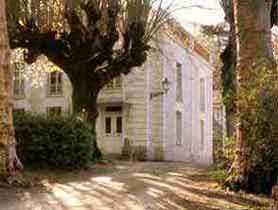 Photo courtesy: Chateau de la Barre |
Choose Your Chateau
The Loire Valley has France’s grandest assemblage of 15th and 16th century chateaus. With 50 to 60 "must see" chateaus scattered on both sides of a 100-mile stretch of the Loire River, the first-time visitor can feel overwhelmed. So with only a few days here, we chose to base ouselves in the heart of the valley, near the friendly village of Amboise, and visit three of the best-known chateaus.
Chenonceau
Chenonceau Chateau stuns you with its two-story, 260-foot Great Gallery arching over the
River Cher. The chateau’s enthralling history shines with the intrigues of several
generations of France’s kings and queens. Originally "acquired" by king
Francois I, it passed to his successor, Henri II, who gifted it in 1547 to his mistress,
Diane de Poitiers. Diane expanded the chateau and built a bridge over the river. When
Henri II died, his wife, Catherine de Medici, took revenge on her rival by forcing Diane
to exchange Chenoncea for nearby Chaumont. Catherine then commissioned the construction of
the bridge gallery. Incredibly extravagant galas were held here until Catherine’s
son, Henry III, was assissinated. His wife, Louise de Savoie, placed the castle in
mourning, furnishing it entirely in black and white.
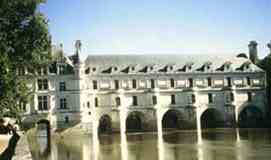 |
 |
The history leaps out as you tour the rooms and the gardens. In WW I the Great Gallery was coverted to a hospital. In WW II the chateau marked the boundary between free and Nazi-occupied France and became the site of prisoner exchanges. Today the chateau and grounds are maintained as if they were at their height under Catherine de Medici. We spent a half-day here, later enjoying a picnic in a quiet corner of the formal gardens as we gazed at the chateau and imagined days of royal intrigue.
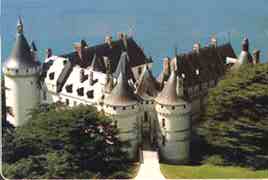 |
Chaumont-sur-Loire Constructed in the 15th century by Lord Amboise on the site of a 10th century feudal fortress, Chaumont commands beautiful views of the Loire River Valley. It was later the home of both Catherine de Medici and Diane de Poitiers of Chenonceau fame. We enjoyed this chateau for its drawbridge, fortress feeling, tapestry, furnishings, and incredible vistas. Renting bicycles in Amboise, we pedaled fifteen flat miles eastward along the river to the village of Chaumont, then climbed the ascending driveway to reach the chateau on its perch above the river. |
Chambord
King Francois I was not content with just the chateaus at Amboise and Chenoncea. He
acquired over 10,000 acres of hunting grounds and decided to build the world’s most
magnificent "hunting lodge." Chambord was built over many decades by Francois
and his successors, Henri II and Charles IX in the 16th century.
| Fully restored now, Chambord stands as the most extravagant of all the Loire chateaus--500 feet wide with 440 rooms and 365 fireplaces. The central grand staircase was purportedly designed by the Italian great, Leonardo da Vinci. It has double sprials which enable two parties of people to ascend and descend simultaneously without crossing paths. Chambord rewarded our visit with its grandeur and extravagance. As we climbed the staircase, toured the rooms, and viewed the grounds from the slate-tiled roof terrace, we repeatedly asked ourselves, "This was a hunting lodge?!" |  |
Enjoy Friendly Amboise
Amboise’s narrowed cobbled streets wind at the base of huge Chateau Amboise. Although only 25% of the original chateau survives, the fortress walls with flying banners looks down on the village and neighboring river. It was here that king Francois I hit his head on a low arch, bringing an early end to his life. The small village sports a friendly feeling, with arched clock tower, cafes, shops, and flower stands.
Not more than a half mile along Rue Victor Hugo from the village center is Le Clos Lucé, a mansion designed and built by Leonardo da Vinci. He lived the last three years of his life here under Francois I’s sponsorship. As we toured the rooms filled with models of Leonardo’s inventions, we could only marvel at his mental powers and foresight 500 years earlier.
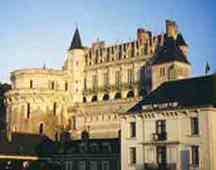 |
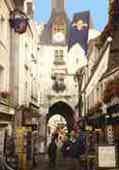 |
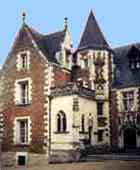 |
The Garden of France
The Marliere’s B & B ("chambres d’hotes"), Chateau de la Barre, is in the countryside only five miles east from Amboise along the Loire river. It was the perfect site from which to bicycle and enjoy the "Garden of France." Small farms dot the relatively flat countryside.
 |
The climate and blue skies led us onward in a spirit of reverie as the miles flew by and we explored the small villages of Chaumont, Valliere, and Souvigny. From time to time we would happen upon a local wine cellar, open for tasting or "dégustation." The Loire’s famous cuisine takes advantage of the local wines (such as Vouvray, Pouilly Fumé), cheeses, fish (trout, salmon), and fruits and vegetables. With Michel Marliere’s excellent cuisine we decided to "eat in" at the B & B each night, but there is a large selection of excellent restaurants in Amboise and other nearby towns. |
When we reluctantly bid farewell to Patricia and Michel we realized the shortness of our four-day stay here. We promised them and ourselves that we would return to Chateau de la Barre for more Loire Valley explorations and their wonderful hospitality.
Click here for details to plan your own trip to France’s Beautiful Loire Valley.
Les Furnanz
Photos by Rita Furnanz